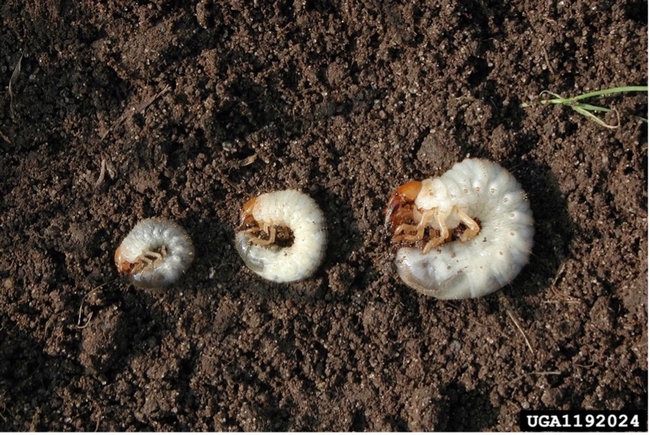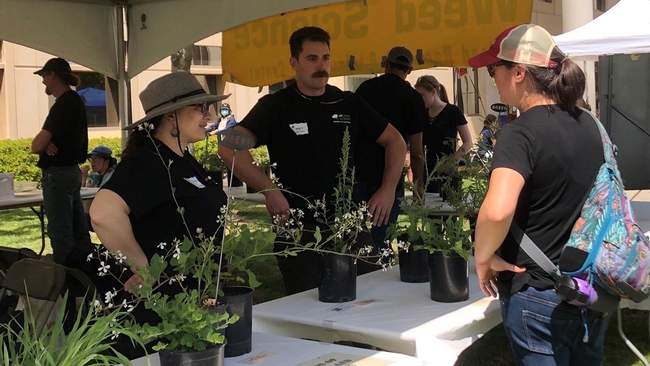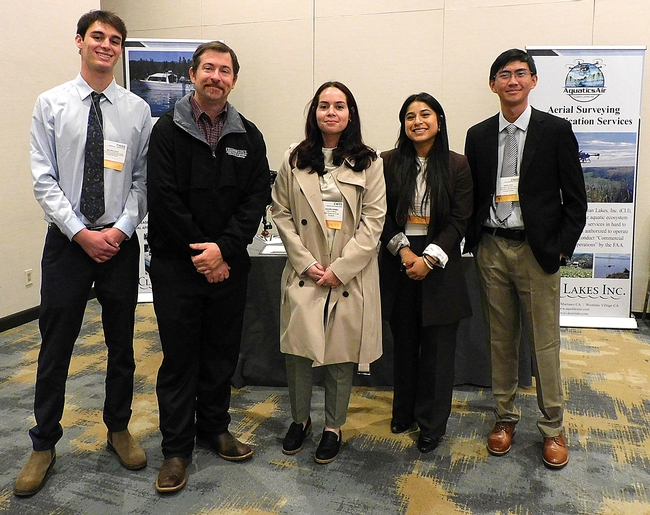- (Focus Area) Pest Management
- Author: Kathy Keatley Garvey
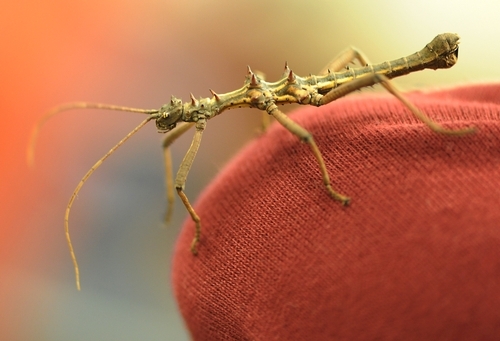
Don't head over to the Bohart Museum of Entomology in the Academic Surge Building on Crocker Lane on Saturday, April 20 during the 110th annual UC Davis Picnic Day.
Why?
It will be closed.
The Bohart Museum, part of the UC Davis Department of Entomology and Nematology (ENT), will be staffing a pop-up tent from noon to 4 p.m. in front of Briggs Hall, home of the department.
That means all the "bug" displays at the 2024 UC Picnic Day will be at one place: Briggs Hall. The Bohart has provided a QR code and the location:
https://maps.app.goo.gl/DLBmhLuEnP1rWjn67.
Tabatha Yang, education and outreach coordinator, says the Bohart Museum is planning four areas of interest:
- The "Oh, my drawers," (California arachnids and wing diversity showcasing cicadas and California dogface butterflies.
- Petting zoo of live insects (thorny sticks), which attendees can hold and photograph. Also shown will be a cicada nymph (from retired Bohart senior museum scientist Steve Heydon) and horntail caterpillars from UC Davis biology lab manager and UC Davis alumna Ivana Li.
- A Bohart poster giveaway--California dogface butterflies.
- A dogface butterfly face banner where attendees can pose for photos
The California dogface butterfly, Zerene eurydice, is California's state insect, as authorized by the State Legislature in 1972. The butterfly is found only in California, from the foothills of the Sierra Nevada to the Coast Ranges and from Sonoma south to San Diego. Its most prevalent habitat is in Auburn at the Placer Land Trust's private conservation site (which the public can see through specially guided tours). Why is it there? Because its larval host plant, false indigo (Amorpha californica) thrives there.
The male, which sports a yellow silhouette of a dog's head on its wings, is known as "the flying pansy." The female is mostly solid yellow except for a single black spot on its upper wings.
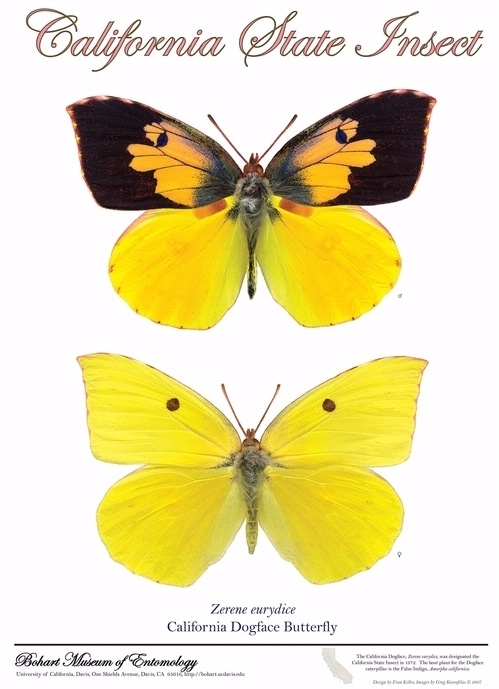
Kareofelas serves as a docent or volunteer tour guide for the Placer Land Trust's dogface butterfly site. He has reared--and photographed--a dogface butterfly from egg to adult. And he's also grown false indigo.
The posters to be given away Saturday--until gone--are the work of Kareofelas and Keller and depict the male and female butterfly.
Theme of the Bohart Museum's Picnic Day display is "Bonding with the Bohart," in reference to Professor Jason Bond, who succeeded UC Davis distinguished professor emerita Lynn Kimsey as director on Feb. 1. Kimsey served 34 years as the director. Although officially retired from the university, she continues to serve as a researcher, and as the executive director of the Bohart Museum Society and editor of the newsletter. Bond is the Evert and Marion Schlinger Endowed Chair of the Department of Entomology and Nematology, and the associate dean, UC Davis College of Agricultural and Environmental Sciences. He also serves as president-elect of the American Arachnological Society.

In addition to the Bohart Museum displays, the entomological events at Briggs Hall will include:
Bug Doctor
Briggs Hall Entryway
Graduate students will answer questions about insects. What's that bug? Attendees are encouraged to bring an insect or photo for identification.
Cockroach Races
Front of Briggs Hall
American cockroaches, Periplaneta americana, from Bob Kimsey's forensic lab, race on a specially made track, while roach fans cheer for their favorites. (Sometimes the athletes are named for faculty, friends or bystanders.
Medical Entomology
122 Briggs Hall
Carla-Cristina "CC" Melo Edwards of the Geoffrey Attardo lab is coordinating the medical entomology display. Her research focuses on investigating the physiological mechanisms underlying pyrethroid resistance in Aedes aegypti (the yellow fever mosquito).
Diversity of Arachnids
122 Briggs Hall
Doctoral student Emma Jochim of the Jason Bond lab is coordinating an exhibit she created last year to display the diversity of arachnids, such as vinegaroons, whip spiders, tarantulas, and scorpions. "We'll have live animals and fact sheets that will give a general overview of their diversity, behavior, and habitat," Jochim said. "I'll also bring some curated specimens to show what goes into creating a scientific collection and talk about why collections are important for understanding biodiversity. "
Maggot Art
Briggs Courtyard
Artists--children and adults alike--create maggot art by dipping a live maggot into water-based, non-toxic paint. It's suitable for framing (or at least a spot on the refrigerator door). This activity will close at 3.
Dr. Death
122 Briggs Hall
Forensic entomologist Robert Kimsey will display and discuss his work.
Entomology at UC Davis
122 Briggs Hall
Displays of insects, including bees, ants and more. Graduate students, faculty and emeriti will staff the tables.
Fly-Tying
Briggs Hall courtyard
Fly Fishers of Davis will show attendees how to tie a fly. The recipients take home the flies.
Insect-Themed T-Shirt Sales
Briggs Hall entryway
Members of the Entomology Graduate Student Association (EGSA), led by president Mia Lippey, will be selling their popular insect-themed t-shirts, including The Beetles.
Mosquito Control Booth
Entrance to Briggs (below front steps)
Sacramento-Yolo Mosquito and Vector Control District will be providing information on mosquitoes, answering questions, and offering give-a-ways.
UC Statewide Integrated Pest Management (UC IPM)
Briggs Hall Courtyard
“We plan to have many of our usual materials on display and will be giving out the live lady beetles (aka ladybugs) again,” said urban and community IPM educator Lauren Fordyce. “We purchase them from a local garden center. In addition to that, we plan to have a prize wheel that adults and kids can spin, answer a question, and win a prize if they answer correctly. We may also have temporary insect tattoos to give away.”

- Author: Lauren Fordyce
While preparing your garden for planting this spring, you may have found white grubs in the soil. While uncovering these sometimes large, white grubs can be alarming, they usually won't cause significant plant damage.
Grubs are the soil-dwelling larvae of several beetles in the Scarabaeidae family. They are generally C-shaped with whitish bodies and 6 legs. The larvae of smaller species may be less than 0.5 inch long, while larger species may be over 1 inch. Some grubs feed on living plant material while others do not.
In most cases, the presence of grubs does not require pesticide treatment and populations of 6 or less per square foot won't cause significant damage. If you notice them in your garden beds, they can be hand-picked and killed. Some may choose to feed them to their backyard chickens or leave them out for wild birds. Beneficial nematodes can be applied to control grub infestations.
To learn more about common white grubs, visit https://ucanr.edu/blogs/blogcore/postdetail.cfm?postnum=56797
- Author: Trina Kleist
- Posted by: Gale Perez
Hanson: “Some weeds you can only eat once”
Our weed doctors will be available to identify weeds and give people advice during the UC Davis Picnic Day this year, from 10 a.m. to 2 p.m. Saturday, April 20, in the Plant & Environmental Sciences (PES) Building courtyard. Research staff have collected seasonal weeds for their “weed petting zoo” to help you identify what's in your lawn, flower bed or horse pasture.
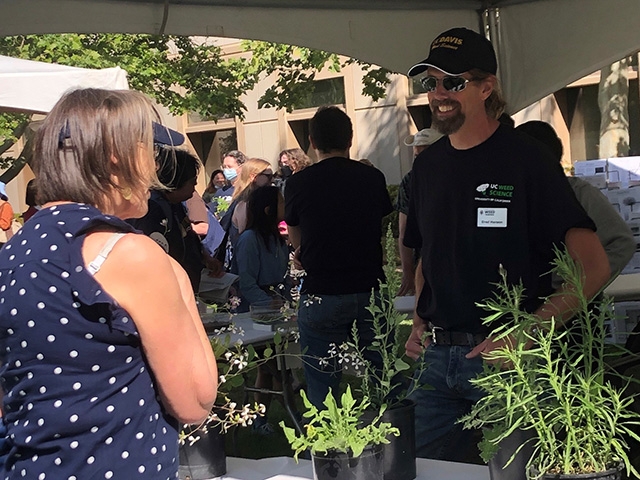
People often ask for low-cost, easy and chemical-free solutions to eradicate weeds, said scientist Brad Hanson. “I usually tell them, ‘Weeds are weeds for a reason,' and they might be more successful if they pick two of those three specifications.” In the case of stubborn perennial pests, the weed doctors can recommend an effective herbicide.
Weeds are a huge problem in our natural lands, too. “Besides affecting landscapes and agricultural fields, weeds are driving ecosystem changes and altering fire regimes in California,” said weed and restoration specialist Justin Valliere. “In many cases, ecological restoration is primarily related to managing and preventing weed invasions.”
Careful what you eat!
Also at this year's "Ask the Weed Doctor" booth will be Jens Beets, the new research ecologist with the United States Department of Agriculture's Agricultural Research Service. Based at UC Davis, Beets is an expert in aquatic plant management.
Information also will be available about aquatic weeds.
Visitors can take home information sheets describing pests and guides from the University of California's Statewide Integrated Pest Management Program. Weed doctors also can point visitors to helpful books, local resources such as a UC Master Gardeners group, and online resources, Hanson added.
Faculty with the Weed Research and Information Center enjoy meeting people and hearing about their weeds. A memorable conversation, Hanson recalled, went like this: “Hey, this one shouldn't be called a weed! If you pick it when it's tender, you can eat it in a salad.” To that, the weed doctor responded, “You can eat any weed, but some of them you only eat once!”
Check out all the information available at the UC Weed Research and Information Center.
Original source: UCD Plant Sciences website • NEWS April 11, 2024
- Author: Kathy Keatley Garvey
Remember when San Francisco 49'ers wide receiver Brandon Aiyuk credited his spectacular 51-yard catch in the 2024 NFC championship game with the Detroit Lions to a ladybug (note that entomologists correctly call it a "lady beetle") landing on his shoe before the game?
Well, those attending the 110th annual UC Davis Picnic Day activities on Saturday, April 20 at Briggs Hall--home of the UC Davis Department of Entomology and Nematology--can also net some luck.
Children are encouraged to take home a couple of the beetles at the UC Statewide Integrated Pest Management Program (UC IPM) booth in the courtyard of Briggs. (Adults can do so, too. Maybe they'll name their beetles "Brandon" and "Aiyuk.")
The ladybug is actually a beetle (Coleoptera), not a bug (Hemiptera). It's associated with good luck because it eats the aphids that try to destroy our crops. It can eat as many as 5000 aphids in its lifetime, scientists estimate.
"These beetles have become a cultural icon of sorts because of their appearance and their beneficial habits," writes UC Davis distinguished professor Lynn Kimsey, former director of the Bohart Museum of Entomology, in her insect fact sheet on lady beetles. "Both adults and larvae feed on aphids and other small, soft-bodied insects...They are ferocious predators on small insects." (See what the UC Statewide Integrated Pest Management Program says about lady beetles.)
Ever seen a close-up shot of a lady beetle eating an aphid? The predator and the prey...
Ever seen a cellar spider snaring and eating a lady beetle? The predator and the predator...one becomes prey.
Ordinarily, the lady beetle's bright red coloration serves as a "warning" to predators. Plus, lady beetles are known to ooze a foul-tasting chemical that tastes so bad that predators leave them alone. This lady beetle engaged in "reflex bleeding," exuding an alkaloid toxin (which did not deter the predator).
Lady beetles will be just a few of the bugs at Briggs Hall during UC Davis Picnic Day. You'll also see cockroach races, maggot art, and displays featuring ants, bees, walking sticks, mosquitoes, nematodes, butterflies, spiders, whip scorpions, and more. Check out "bug" activities at Briggs Hall here. UC Davis Picnic Day is free and family friendly.


- Author: Thomas J Getts
****
Students, it is the time of year to apply for the CWSS Student Scholarship! Awards will be given to both graduate and undergraduate students ranging from $1,000-2,000. Any students interested in Weed Science should apply! Click here to submit an application and for further instruction.
****
This year in January at the California Weed Science Society (CWSS) annual conference, we had numerous outstanding students present their recent research in the field of weed science. In total we had 12 students participate in the contest, but there is always room for more! If you know of any undergraduate or graduate students who are interested in weeds, I would encourage them to get involved with the CWSS. It is a great conference with many networking and learning opportunities.

This year we had one winner in the undergraduate student poster contest.
- 1st Place Undergraduate Student Poster - Sawyer William Claussen, California Polytechnic University San Luis Obispo (Steinmaus Lab) - Biannual Crop Rotation as an Effective Weed Management Method
For the Graduate Student Contest, the two prize winners were from UC Davis!
- 1st Place Graduate Poster - Stephen Chang, UC Davis (Hanson Lab) - Evaluating the Effect of Endothall-treated Irrigation Water on California Crops
- 2nd Place Graduate Poster - Erika Escalona, UC Davis (Fennimore Lab) - Evaluating Bacterial Diversity and Efficacy of Steam Fumigation Treatments in the Salinas Valley's Lettuce and Spinach Fields
Fresno State swept the oral competition this year!
- 1st Place Graduate Paper - Robert Willmott, Fresno State University (Shrestha Lab) - Cover Crops Combined with Strip Tilling Reduces Herbicide Use in Silage Corn
- 2nd Place Graduate Paper - Jennifer Valdez Herrera, Fresno State University (Shrestha Lab) - Developing an Integrated Management System for Common Chickweed (Stellaria media) Control in Small Grain Crops in the Central Valley
If you see any of these excellent students, make sure to give them a big congratulations! And encourage students you know to apply for the scholarship program!

